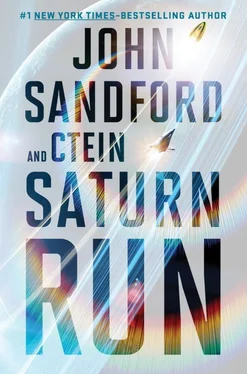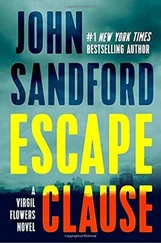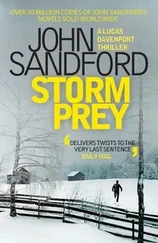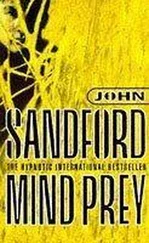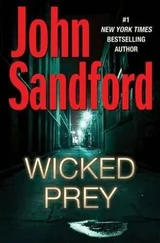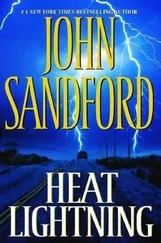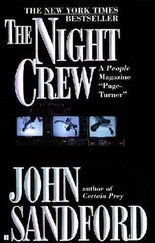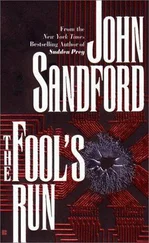The trip from Earth to Saturn had been the fastest done by any human-built craft, ever—so fast that collision with even a brick-sized object would have been a disaster. But space was remarkably empty, even of sand-sized objects.
Saturn’s ring system was another matter. The rings were only tens of meters thick, but that space was filled with icy objects of all different sizes. If the Nixon crossed the densest rings it would inevitably be struck multiple times by hail-sized and larger—much larger—ice balls moving at many kilometers per second relative to the ship.
Their goal, the alien mystery, orbited Saturn within the translucent C Ring’s Maxwell Gap. The Nixon could safely orbit within that region, twenty-seven thousand kilometers above Saturn’s cloud tops, if it could get there.
The Maxwell Gap was near the innermost edge of the huge ring system. Between the gap and deep space was a fifty-thousand-kilometer disk of icy projectiles. If the Nixon tried to come into Saturn on a straightforward equatorial path in the plane of the rings, it would be sliced in two by a twenty-meter-thick buzz saw of ring-particle impacts before it got one percent of the way in.
Instead, the ship approached on a vector that was tilted at thirty degrees to the ring plane, decelerating the whole way on an inward spiral, reminiscent of the one that had taken them out of Earth orbit.
It was a week’s work for the VASIMRs to slow the ship enough to bring it into a circular orbit that threaded the Maxwell Gap; along that spiral trajectory the ship had to cross the ring plane many times. Each ring encounter lasted only a few milliseconds, but they were potentially lethal ones.
Fortunately, Saturn’s rings weren’t uniform. They were divided into thousands of ringlets and lesser gaps, like grooves on a giant celestial record. The inbound trajectory wasn’t a simple smooth spiral. The deceleration was carefully modulated and timed so that each ring crossing would pass through one of those myriad smaller gaps that subdivided the ring system.
Ship’s navigation had carried the burden of responsibility for this segment of the flight. This was not the usual preset deep space trajectory, determined well in advance of the flight. From far off, Saturn’s rings appeared stable and fixed, but those ringlets performed a constant and chaotic dance with gravity. Gaps would shift kilometers inward or outward. Sometimes they disappeared entirely. Changes could happen in weeks, sometimes days; it was impossible to plan out a precise trajectory far in advance of the Nixon ’s arrival at Saturn.
So the nav crew actually had to “fly” the ship in, working with a constant stream of communication between the astronomers, Navigation, and Engineering. Navigation would say where they hoped to take the ship, the astronomers would tell them what gaps were close to their desired path, Navigation would calculate a course correction, and Engineering would execute it or tell them it wasn’t feasible and they’d better look for a different gap.
It was nerve-racking. Haggard didn’t begin to describe the flight crew’s appearance by week’s end.
____
The majority of the ship’s complement, who weren’t involved in the life-and-death decisions, had an entirely different experience. They were entranced. Saturn, ten times the size of the earth, was a beautiful object to behold. When the Nixon made its first pass by Saturn, outside the F Ring, the flattened disk of Saturn, all by itself, spanned a fifty-degree field of view and the rings, the most gorgeous planetary system known to humanity, filled the sky.
People couldn’t get enough of the spectacle. The Commons was always packed to capacity. Anyone whose duties didn’t require them to be elsewhere crowded to see the amazing sight that swept past the window. They marveled at the huge pearly-white arcs of the rings and the perpetually fascinating colors of Saturn’s cloud bands striped with tawny hues of oranges, ochers, tans, salmons, more different and delicate colors than most of the crew had names for.
The ring crossings were even more popular, if that were possible. Approaching from the sunlit side, the rings grew ever bigger in the window until they occupied the entire view. Unbelievably detailed and striated, rings became ringlets, ringlets parsed into sub-ringlets, ever-finer textures that grew and grew and then suddenly they were through the ring and looking at empty space. Half a rotation of the living modules, and the rings came back into view, sometimes glowing with ghostly pale backlighting from the sun. Where Saturn’s shadows fell across the rings, they were visible only as dark sweeping silhouettes that blocked out the distant stars.
The flight crew’s anxiety never managed to infect the spectators. Intellectually, the spectators knew that ring crossings were one of the riskiest parts of the mission. They just didn’t feel it. They’d survived a close pass by the sun, a crippling accident at the orbit of Jupiter that had killed one of their own and nearly ruined the mission, months in space far beyond the reach of the rest of humanity, and here they were. Deep in their emotional cores, they knew nothing would go wrong.
They were right. Nothing did go wrong. The ship took some minor hits from some minor bits of ice in the gaps. Nothing the structured foam hulls and carbon composite skeletons couldn’t handle, and nothing that service egg jockeys couldn’t repair once they were settled in.
Each pass through the potentially hazardous ring gaps came more quickly on the heels of the last. The first ring crossings were separated by a day and a half. Just before the Nixon finally settled into the inclined circular orbit that threaded the Maxwell Gap, the crossings were three and a half hours apart.
Then they were close.
____
“What do we know?” Fang-Castro asked.
They were gathered in the Commons, which had been declared temporarily off-limits to anyone not invited—not because there were any secrets, but because there wasn’t enough room for everybody who wanted to attend. The chairs were mostly occupied by the science crew, along with representatives from Navigation and Engineering. Sandy was recording the meeting, which was being transmitted directly back to Earth on an encrypted link.
“We’re poking at it with everything we’ve got,” said Barney Kapule, a ranging and surveillance expert, one of two on board. The two had been chosen for their expertise in operating the onboard telescopes and the associated cameras. Everything they saw in their scopes was on its way back to Earth within milliseconds.
What had appeared two years earlier to be idle speculation by Richard Emery, the vice chair of the Joint Chiefs of Staff, was close to spot-on.
“This is no moonlet,” Kapule said. “Our primary object is the size of a minor moon, an oblate spheroid a good five kilometers in diameter.” He tapped his slate and a vid of the object popped up on the oversized Commons vid screen. “It has minimal perturbing effect on the rings, so it has to be very low in density. In other words, we think it’s hollow, so it’s not a natural object. Whether it ever was a natural object, we don’t know yet. The surface is irregular. At this distance, we can’t tell if it’s natural weathered material, you know, roughened up by occasional small impacts over the years, or an artificial shell with a lot of hardware stuck on the outside.”
“Why can’t we see it better?” John Clover asked.
“Because it’s dark—not exactly stealth-black, but the surface is very, very dark, shading to a lighter gray at both of the poles,” said Candace Frank, Kapule’s associate. She touched her slate and brought up a different view of the object. “Whether or not this was intentional camouflage, it made the primary difficult to pick out in the Maxwell Gap as anything more than a minor moonlet. But it is more, a lot more. Not only do we have the primary, but it has a substantial retinue of dozens of additional moonlets, considerably less than a hundred meters in size. They appear to orbit in a fixed formation with the primary, and statistically there’s no possibility that the formation is natural. They were placed where they’re at. Whether they’re physically connected or just station-keeping, we can’t tell at this distance, but they’re all associated with each other.”
Читать дальше
